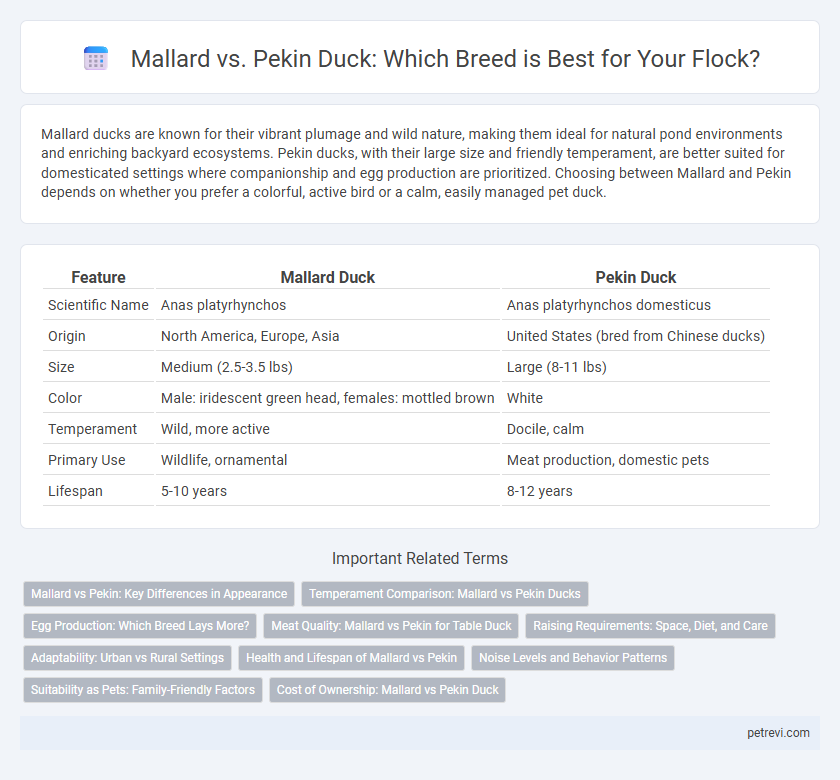Mallard ducks are known for their vibrant plumage and wild nature, making them ideal for natural pond environments and enriching backyard ecosystems. Pekin ducks, with their large size and friendly temperament, are better suited for domesticated settings where companionship and egg production are prioritized. Choosing between Mallard and Pekin depends on whether you prefer a colorful, active bird or a calm, easily managed pet duck.
Table of Comparison
| Feature | Mallard Duck | Pekin Duck |
|---|---|---|
| Scientific Name | Anas platyrhynchos | Anas platyrhynchos domesticus |
| Origin | North America, Europe, Asia | United States (bred from Chinese ducks) |
| Size | Medium (2.5-3.5 lbs) | Large (8-11 lbs) |
| Color | Male: iridescent green head, females: mottled brown | White |
| Temperament | Wild, more active | Docile, calm |
| Primary Use | Wildlife, ornamental | Meat production, domestic pets |
| Lifespan | 5-10 years | 8-12 years |
Mallard vs Pekin: Key Differences in Appearance
Mallard ducks display iridescent green heads, white neck rings, and mottled brown bodies, with males showcasing a distinct vibrant coloration unlike the uniformly white feathers of Pekin ducks. Pekins are larger with a bulkier body and an upright posture, while Mallards have a slimmer build and a more streamlined silhouette. The bill color is another key distinction, with Mallards featuring yellow or greenish bills and Pekins possessing bright orange bills.
Temperament Comparison: Mallard vs Pekin Ducks
Mallard ducks exhibit a more wild and alert temperament, often displaying skittish behavior and strong flight instincts, making them less approachable for domestication. Pekin ducks are known for their calm, friendly, and sociable nature, which contributes to their popularity as pets and farm animals due to their ease of handling. The temperament differences between Mallard and Pekin ducks significantly influence their suitability for different environments, with Pekins being better suited for backyard flocks and Mallards thriving in more natural, less human-centric habitats.
Egg Production: Which Breed Lays More?
Mallard ducks typically lay around 100 to 150 eggs per year, while Pekin ducks are known for their higher egg production, averaging 200 to 250 eggs annually. Pekin ducks produce larger eggs with a consistent shell quality, making them preferred for commercial egg production. Mallards have a more varied laying pattern due to their wild ancestry, whereas Pekins exhibit more reliable and frequent egg-laying cycles.
Meat Quality: Mallard vs Pekin for Table Duck
Mallard ducks offer a leaner meat with a stronger, gamey flavor, making them favored for gourmet dishes and traditional recipes. Pekin ducks provide tender, mild-flavored meat with higher fat content, preferred for rich and juicy roasted or braised preparations. For table duck, Pekin meat is often chosen for its consistency and tenderness, while Mallard meat appeals to those seeking a distinct, robust taste.
Raising Requirements: Space, Diet, and Care
Mallard ducks require more space and access to natural water sources to thrive, while Pekin ducks adapt well to confined spaces and small ponds. Diet-wise, Mallards consume a varied diet of aquatic plants, insects, and small fish, whereas Pekins primarily eat commercial duck feed supplemented with grains and greens. Care for Mallards involves more attention to their diverse habitat needs and protection from predators, while Pekins demand regular cleaning of living areas and consistent feeding schedules for optimal growth.
Adaptability: Urban vs Rural Settings
Mallard ducks exhibit high adaptability to both urban and rural environments due to their wild ancestry, allowing them to thrive in diverse water bodies and handle variable food sources. Pekin ducks, bred primarily for meat production, perform best in rural or farm settings where space and controlled feeding are available, and they are less suited to the unpredictable conditions of urban areas. The Mallard's natural foraging skills and resilience make it an ideal choice for city parks and suburban ponds, while the Pekin requires more care and structured environments to maintain health and productivity.
Health and Lifespan of Mallard vs Pekin
Mallard ducks typically exhibit robust health and a longer lifespan, averaging 8 to 12 years, due to their wild origin and natural adaptability. Pekin ducks, bred primarily for domestic use, tend to have a shorter lifespan of about 5 to 7 years and may face more health issues like respiratory problems and obesity from selective breeding. Health management for Pekins requires careful diet and environment control to prevent common ailments, whereas Mallards generally thrive with minimal intervention.
Noise Levels and Behavior Patterns
Mallard ducks typically exhibit moderate noise levels, making them suitable for environments where quieter animals are preferred, while Pekin ducks are known for being louder, often vocalizing frequently. Behaviorally, Mallards are more agile and active, showing a strong inclination for foraging and flying, whereas Pekins are calmer, more sedentary, and better adapted to confined spaces. Choosing between these breeds depends on the need for quieter surroundings or ease of management with more docile behavior.
Suitability as Pets: Family-Friendly Factors
Mallard ducks, known for their natural instincts and active behavior, require more space and care, which can be challenging for families with young children. Pekin ducks, characterized by their calm demeanor and sociable nature, are better suited as pets for families due to their adaptability to confinement and gentle temperament. The low maintenance and friendly habits of Pekin ducks make them a popular choice for first-time duck owners seeking a family-friendly pet.
Cost of Ownership: Mallard vs Pekin Duck
Mallard ducks generally have a lower initial cost but require more specialized care, which can increase long-term expenses compared to Pekin ducks. Pekin ducks, known for their hardiness and fast growth, tend to have higher upfront costs but lower ongoing maintenance due to their adaptability and ease of feeding. Overall, Pekin ducks offer a more cost-effective ownership experience for beginner enthusiasts, while Mallards may appeal to those willing to invest more in habitat and diet management.
Mallard vs Pekin for Duck breed Infographic

 petrevi.com
petrevi.com